|
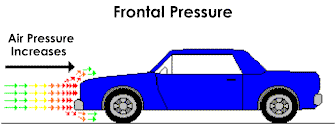
Tips: Aerodynamics
The following tips and information focus on how to optimize aerodynamics. Depending on
class rules, these suggestions may or may not be valid. Always check your regulations.
General Aerodynamics
Principles
Aerodynamic Devices
Aerodynamics Design Tips
General
Aerodynamic Principals
|
Drag
A simple definition of aerodynamics is the
study of the flow of air around and through a vehicle, primarily if it is in motion. To
understand this flow, you can visualize a car moving through the air. As we all know, it
takes some energy to move the car through the air, and this energy is used to overcome a
force called Drag.
Drag, in vehicle aerodynamics, is comprised
primarily of two forces. Frontal pressure is caused by the air attempting to flow
around the front of the car. As millions of air molecules approach the front grill of the
car, they begin to compress, and in doing so raise the air pressure in front of the car.
At the same time, the air molecules traveling along the sides of the car are at
atmospheric pressure, a lower pressure compared to the molecules at the front of the car.
Just like an air tank, if the valve to the
lower pressure atmosphere outside the tank is opened, the air molecules will naturally
flow to the lower pressure area, eventually equalizing the pressure inside and outside the
tank. The same rules apply to cars. The compressed molecules of air naturally seek a way
out of the high pressure zone in front of the car, and they find it around the sides, top
and bottom of the car. See the diagram below.

Rear vacuum (a non-technical term, but
very descriptive) is caused by the "hole" left in the air as the car passes
through it. To visualize this, imagine a bus driving down a road. The blocky shape of the
bus punches a big hole in the air, with the air rushing around the body, as mentioned
above. At speeds above a crawl, the space directly behind the bus is "empty" or
like a vacuum. This empty area is a result of the air molecules not being able to fill the
hole as quickly as the bus can make it. The air molecules attempt to fill in to this area,
but the bus is always one step ahead, and as a result, a continuous vacuum sucks in the
opposite direction of the bus. This inability to fill the hole left by the bus is
technically called Flow detachment. See the diagram below.
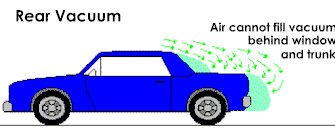
Flow detachment applies only to the
"rear vacuum" portion of the drag equation, and it is really about giving the
air molecules time to follow the contours of a car's bodywork, and to fill the hole left
by the vehicle, it's tires, it's suspension and protrusions (ie. mirrors, roll bars). If
you have witnessed the Le Mans race cars, you will have seen how the tails of these cars
tend to extend well back of the rear wheels, and narrow when viewed from the side or top.
This extra bodywork allows the air molecules to converge back into the vacuum smoothly
along the body into the hole left by the car's cockpit, and front area, instead of having
to suddenly fill a large empty space.
The reason keeping flow attachment is so
important is that the force created by the vacuum far exceeds that created by frontal
pressure, and this can be attributed to the Turbulence created by the detachment.
Turbulence generally affects the "rear
vacuum" portion of the drag equation, but if we look at a protrusion from the race
car such as a mirror, we see a compounding effect. For instance, the air flow detaches
from the flat side of the mirror, which of course faces toward the back of the car. The
turbulence created by this detachment can then affect the air flow to parts of the car
which lie behind the mirror. Intake ducts, for instance, function best when the air
entering them flows smoothly. Therefore, the entire length of the car really needs to be
optimized (within reason) to provide the least amount of turbulence at high speed. See
diagram below (Light green indicates a vacuum-type area behind mirror):
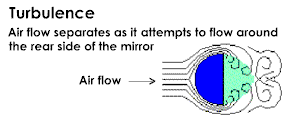
Lift (or Down
force)
One term very often heard in race car circles
is Down force. Down force is the same as the lift experienced by airplane wings,
only it acts to press down, instead of lifting up. Every object traveling through air
creates either a lifting or down force situation. Race cars, of course use things like
inverted wings to force the car down onto the track, increasing traction. The average
street car however tends to create lift. This is because the car body shape itself
generates a low pressure area above itself.
How does a car generate this low pressure
area? According to Bernoulli, the man who defined the basic rules of fluid dynamics, for a
given volume of air, the higher the speed the air molecules are traveling, the lower the
pressure becomes. Likewise, for a given volume of air, the lower the speed of the air
molecules, the higher the pressure becomes. This of course only applies to air in motion
across a still body, or to a vehicle in motion, moving through still air.
When we discussed Frontal Pressure, above,
we said that the air pressure was high as the air rammed into the front grill of the car.
What is really happening is that the air slows down as it approaches the front of the car,
and as a result more molecules are packed into a smaller space. Once the air Stagnates
at the point in front of the car, it seeks a lower pressure area, such as the sides, top
and bottom of the car.
Now, as the air flows over the hood of the
car, it's loses pressure, but when it reaches the windscreen, it again comes up against a
barrier, and briefly reaches a higher pressure. The lower pressure area above the hood of
the car creates a small lifting force that acts upon the area of the hood (Sort of like
trying to suck the hood off the car). The higher pressure area in front of the windscreen
creates a small (or not so small) down force. This is akin to pressing down on the
windshield.
Where most road cars get into trouble is the
fact that there is a large surface area on top of the car's roof. As the higher pressure
air in front of the wind screen travels over the windscreen, it accelerates, causing the
pressure to drop. This lower pressure literally lifts on the car's roof as the air passes
over it. Worse still, once the air makes it's way to the rear window, the notch created by
the window dropping down to the trunk leaves a vacuum, or low pressure space that the air
is not able to fill properly. The flow is said to detach and the resulting lower
pressure creates lift that then acts upon the surface area of the trunk. This can be seen
in old 1950's racing sedans, where the driver would feel the car becoming
"light" in the rear when traveling at high speeds. See the diagram below.
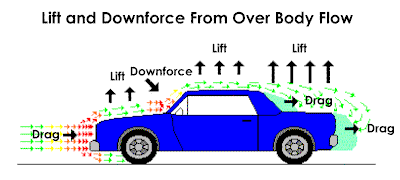
Not to be forgotten, the underside of the car
is also responsible for creating lift or down force. If a car's front end is lower than
the rear end, then the widening gap between the underside and the road creates a vacuum,
or low pressure area, and therefore "suction" that equates to down force. The
lower front of the car effectively restricts the air flow under the car. See the diagram
below.
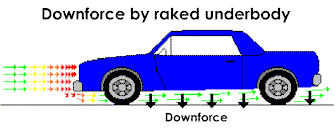
So, as you can see, the airflow over a car is
filled with high and low pressure areas, the sum of which indicate that the car body
either naturally creates lift or down force.
Drag Coefficient
The shape of a car, as the aerodynamic theory
above suggests, is largely responsible for how much drag the car has. Ideally, the car
body should:
- Have a small grill, to minimize frontal
pressure.
- Have minimal ground clearance below the grill,
to minimize air flow under the car.
- Have a steeply raked windshield to avoid
pressure build up in front.
- Have a "Fastback" style rear window
and deck, to permit the air flow to stay attached.
- Have a converging "Tail" to keep the
air flow attached.
- Have a slightly raked underside, to create low
pressure under the car, in concert with the fact that the minimal ground clearance
mentioned above allows even less air flow under the car.
If it sounds like we've just described a
sports car, you're right. In truth though, to be ideal, a car body would be shaped like a
tear drop, as even the best sports cars experience some flow detachment. However, tear
drop shapes are not conducive to the area where a car operates, and that is close to the
ground. Airplanes don't have this limitation, and therefore teardrop shapes work.
What all these "ideal" attributes
stack up to is called the Drag coefficient (Cd). The best road cars today manage a
Cd of about 0.28. Formula 1 cars, with their wings and open wheels (a massive drag
component) manage a minimum of about 0.75.
If we consider that a flat plate has a Cd of
about 1.0, an F1 car really seems inefficient, but what an F1 car lacks in aerodynamic
drag efficiency, it makes up for in down force and horsepower.
Frontal Area
Drag coefficient, by itself is only useful in
determining how "Slippery" a vehicle is. To understand the full picture, we need
to take into account the frontal area of the vehicle. One of those new aerodynamic
semi-trailer trucks may have a relatively low Cd, but when looked at directly from the
front of the truck, you realize just how big the Frontal Area really is.
It is by combining the Cd with the Frontal
area that we arrive at the actual drag induced by the vehicle.
Scoops
Scoops, or positive pressure intakes, are
useful when high volume air flow is desirable and almost every type of race car makes use
of these devices. They work on the principle that the air flow compresses inside an
"air box", when subjected to a constant flow of air. The air box has an opening
that permits an adequate volume of air to enter, and the expanding air box itself slows
the air flow to increase the pressure inside the box. See the diagram below:

NACA Ducts
NACA stands for "National Advisory Committee for
Aeronautics". NACA is one of the predecessors of NASA. In the early days of aircraft
design, NACA would mathematically define airfoils (example: NACA 071) and publish them in
references, from which aircraft manufacturers would get specific applications
The purpose of a NACA duct is to increase the flowrate of air
through it while not disturbing the boundary layer. When the cross-sectional flow area of
the duct is increased, you decrease the static pressure and make the duct into a vacuum
cleaner, but without the drag effects of a plain scoop. The reason why the duct is narrow,
then suddenly widens in a graceful arc is to increase the cross-sectional area slowly so
that airflow does separate and cause turbulence (and drag).
NACA ducts are useful when air needs to be
drawn into an area which isn't exposed to the direct air flow the scoop has access to.
Quite often you will see NACA ducts along the sides of a car. The NACA duct takes
advantage of the Boundary layer, a layer of slow moving air that "clings"
to the bodywork of the car, especially where the bodywork flattens, or does not accelerate
or decelerate the air flow. Areas like the roof and side body panels are good examples.
The longer the roof or body panels, the thicker the layer becomes (a source of drag that
grows as the layer thickens too).
Anyway, the NACA duct scavenges this slower
moving area by means of a specially shaped intake. The intake shape, shown below, drops in
toward the inside of the bodywork, and this draws the slow moving air into the opening at
the end of the NACA duct. Vortices are also generated by the "walls" of the duct
shape, aiding in the scavenging. The shape and depth change of the duct are critical for
proper operation.
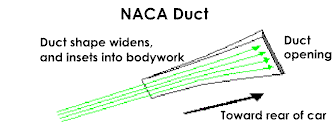
Typical uses for NACA ducts include engine
air intakes and cooling.
Spoilers
Spoilers are used primarily on sedan-type
race cars. They act like barriers to air flow, in order to build up higher air pressure in
front of the spoiler. This is useful, because as mentioned previously, a sedan car tends
to become "Light" in the rear end as the low pressure area above the trunk lifts
the rear end of the car. See the diagram below:
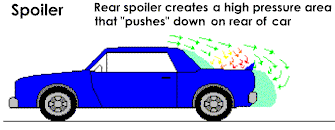
Front air dams are also a form of spoiler,
only their purpose is to restrict the air flow from going under the car.
Wings
Probably the most popular form of aerodynamic
aid is the wing. Wings perform very efficiently, generating lots of down force for a small
penalty in drag. Spoiler are not nearly as efficient, but because of their practicality
and simplicity, spoilers are used a lot on sedans.
The wing works by differentiating pressure on
the top and bottom surface of the wing. As mentioned previously, the higher the speed of a
given volume of air, the lower the pressure of that air, and vice-versa. What a wing does
is make the air passing under it travel a larger distance than the air passing over it (in
race car applications). Because air molecules approaching the leading edge of the wing are
forced to separate, some going over the top of the wing, and some going under the bottom,
they are forced to travel differing distances in order to "Meet up" again at the
trailing edge of the wing. This is part of Bernoulli's theory.
What happens is that the lower pressure area
under the wing allows the higher pressure area above the wing to "push" down on
the wing, and hence the car it's mounted to. See the diagram below:
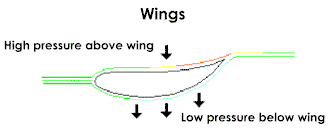
Wings, by their design require that there be
no obstruction between the bottom of the wing and the road surface, for them to be most
effective. So mounting a wing above a trunk lid limits the effectiveness.
- Cover Open wheels. Open wheels create a
great deal of drag and air flow turbulence, similar to the diagram of the mirror above.
Full covering bodywork is probably the best solution, if legal by regulations, but if
partial bodywork is permitted, placing a converging fairing behind the wheel provides
maximum benefit.
- Minimize Frontal Area. It's no
coincidence that Formula 1 cars are very narrow. It is usually much easier to reduce FA
(frontal area) than the Cd (Drag coefficient), and top speed and acceleration will be that
much better.
- Converge Bodywork Slowly. Bodywork
which quickly converges or is simply truncated, forces the air flow into turbulence, and
generates a great deal of drag. As mentioned above, it also can affect aerodynamic devices
and bodywork further behind on the car body.
- Use Spoilers. Spoilers are widely used
on sedan type cars such as NASCAR stock cars. These aerodynamic aids produce down force by
creating a "dam" at the rear lip of the trunk. This dam works in a similar
fashion to the windshield, only it creates higher pressure in the area above the trunk.
- Use Wings. Wings are the inverted
version of what you find on aircraft. They work very efficiently, and in less aggressive
forms generate more down force than drag, so they are loved in many racing circles. Wings
are not generally seen in concert with spoilers, as they both occupy similar locations,
and defeat each other's purpose.
- Use Front Air Dams. Air dams at the
front of the car restrict the flow of air reaching the underside of the car. This creates
a lower pressure area under the car, effectively providing down force.
- Use Aerodynamics to Assist Car Operation. Using
car bodywork to direct airflow into side pods, for instance, permits more efficient (i.e..
smaller FA) side pods. Quite often, with some for-thought, you can gain an advantage over
a competitor by these small dual purpose techniques.
Another useful technique is to use the natural high
and low pressure areas created by the bodywork to perform functions. For instance,
Mercedes, back in the 1950s placed radiator outlets in the low pressure zone behind the
driver. The air inlet pressure which fed the radiator became less critical, as the low
pressure outlet area literally sucked air through the radiator.
A useful high pressure area is in front of
the car, and to make full use of this area, the nose of the car is often slanted downward.
This allows the higher air pressure to push down on the nose of the car, increasing grip.
It also has the advantage of permitting greater driver visibility.
- Keep Protrusions Away From The Bodywork. The
smooth airflow achieved by proper bodywork design can be messed up quite easily if a
protrusion such as a mirror is too close to it. Many people will design very aerodynamic
mounts for the mirror, but will fail to place the mirror itself far enough from the
bodywork.
- Rake the chassis. The chassis, as
mentioned in the aerodynamics theory section above, is capable of being slightly lower to
the ground in the front than in the rear. The lower "Nose" of the car reduces
the volume of air able to pass under the car, and the higher "Tail" of the car
creates a vacuum effect which lowers the air pressure.
- Cover Exposed Wishbones. Exposed
wishbones (on open wheel cars) are usually made from circular steel tube, to save cost.
However, these circular tubes generate turbulence. It would be much better to use oval
tubing, or a tube fairing that creates an oval shape over top of the round tubing. See
diagram below:
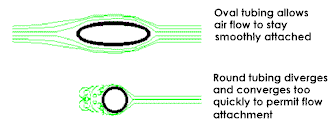
Reprint from gmecca.com



Copyright 2007 Unlimited
Performance Products. All rights reserved. UP22.com, UnlimitedProducts.com,
RaceHoods.com
|
![]()
![]()
![]()










